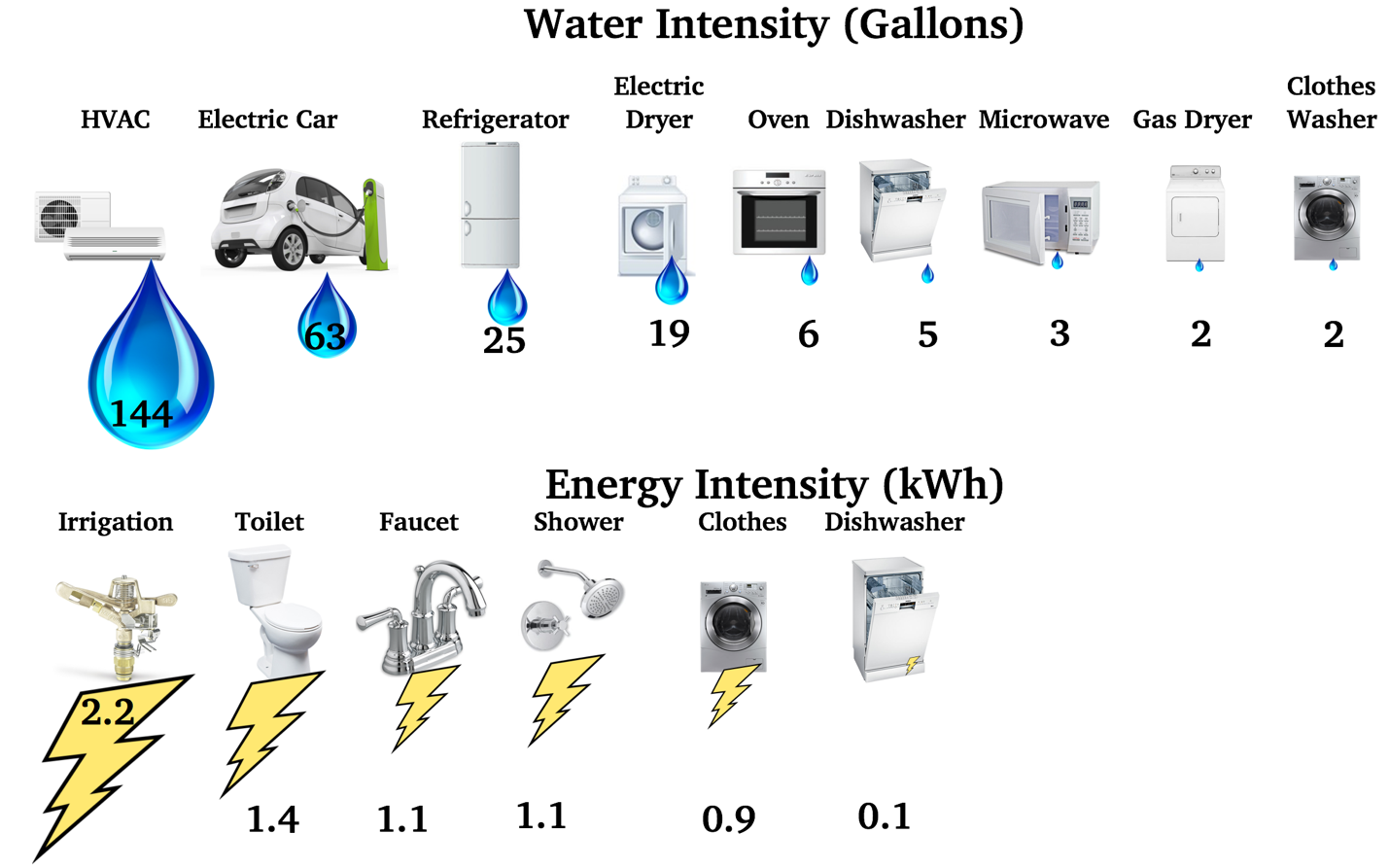Home is Where the Smart Is: First-of-its-Kind Study Reveals Importance of Smart Technology and Low-Water Clean Energy
 Dustin McCartney, senior data analyst at Pecan Street, co-authored this post.
Dustin McCartney, senior data analyst at Pecan Street, co-authored this post.
Have you ever thought about how much water your dryer needs to dry your clothes? (And no, I don’t mean your washing machine.)
Every appliance in your home has a water intensity, or the amount of water needed to make and send the electricity that powers it. On the flip side, all water – like in your faucet, toilet, and irrigation system – has an energy intensity, the amount of electricity needed to treat, distribute, or heat the water. Chances are, you probably haven’t given much consideration to the water intensity of your home energy, or the energy intensity of your water. There hasn’t been any data at the household level – until now.
Environmental Defense Fund (EDF) recently teamed up with Pecan Street, Inc. to examine these combined metrics in a new study. Pecan Street, a research group running the most extensive energy-tracking in U.S. history, analyzed the energy and water costs of a group of Austin homes and their appliances.
By gathering granular data on how much energy and water households use, as well as their associated energy and water intensities, this study reinforces the need for smart technology to help us better understand and manage energy and water. Moreover, in order to safeguard water supplies, the analysis demonstrates the importance of powering our lives with low-water clean energy resources.
How’d they do it?
Pecan Street installed BluCubes (gateways developed in the Pecan Street lab to collect water-use data) in homes that already had the lab’s high-resolution electricity measurement equipment installed. Using data from these two sources, Pecan Street identified large water users, such as air conditioning systems and electric vehicles.
Many of the homes were in Pecan Street’s Mueller neighborhood, one of the world’s largest “living laboratories” for smart grid technology. These homes are more efficient than average and have virtually no lawns (meaning a non-Mueller home’s energy and water use could be significantly higher than the study’s findings).
The average monthly water and energy intensities are shown in the figure below.

Smart tech for smart homes
The study’s findings are remarkable and show that energy-water data is essential for empowering customers to make smart behavioral changes that improve multiple bottom lines:
- An inefficient fight against hot and dry summers – Air conditioning is the most water-intensive and irrigation is the most energy-intensive, and the intensity of both spikes dramatically during hot, dry summer months. In fact, climate and weather significantly impact energy and water use: It took 20 times as much water to power ACs during the sunny, hot days of July than in February; and the energy intensity of home irrigation systems more than doubled in the same time period.
- That garage fridge-freezer combo is more than an eye sore – One surprising finding came from the one home in the study with an upright fridge-freezer combo and a wine fridge in the garage. In July, the combined consumption of these two appliances came in second only to air conditioning as the most water-intensive appliance, meaning it surpassed electric vehicle charging and was three times that of any appliance inside the home. In a state like Texas where many homes use garage refrigerators and freezers, that’s a huge water impact. Think back to 2011’s landmark drought, and the massive strain garage refrigerators and freezers were most likely placing on water supplies during the summer. Armed with what we know now, consumers could have been encouraged to change those practices in order to save water.
- Your dryer is a water guzzler – The study found that powering a gas clothes dryer requires as much water as powering a washing machine, and an electric dryer needs significantly more.
In order to efficiently manage our energy and water resources, we have to understand how we are using each, and smart meters – for both electricity and water – can help us get there. This data can enable households, communities, and planners to improve their energy and water demands, and lead to targeted conservation that will get the most bang for a buck.
Clean energy saves water
By illuminating the tie between energy and water, this study also emphasizes the importance of clean energy in the home. Traditional power sources – like coal and natural gas – require significant amounts of water to create energy. That’s why charging your electric vehicle (EV), which may seem like it needs no water, actually has a high water-intensity.
Clean energy resources like solar panels and energy efficiency, on the other hand, require little to no water. In fact, 21 of the 30 homes examined in the Pecan Street study had solar panels, and those homes were able to reduce their water footprint of energy used by approximately 79 percent. By offsetting the water required to make and send electricity to homes, solar can not only reduce your energy bill, but could reduce pressure on local water supplies that would otherwise be needed for generating more traditional power.
With the electrification of transportation, we need to encourage greater use of low-water, clean energy resources for charging.
There’s also EV charging, which remained consistent throughout the year and was often the most water-intensive energy user in the study’s homes. As the integration of more electric vehicles and charging stations is underway, policymakers need to consider the effect that has on our electric demand, and consequently water demand. With the electrification of transportation, we need to encourage greater use of low-water, clean energy resources for charging.
It is important to understand not just straight energy and water use, but how much is embedded in the other. EDF and Pecan Street are helping us take that first step. Many utilities already offer free or low-cost electric smart meters, and more are beginning to offer smart water meters. Further, many electric utilities offer programs to help customers install more clean energy solutions in their homes, including energy efficiency upgrades and solar panels. Policymakers and regulators should continue to increase access to these smart technologies and clean energy resources, so we can have a more comprehensive picture of our energy and water use while protecting our water supplies.
This post originally appeared on our Texas Clean Air Matters blog.










